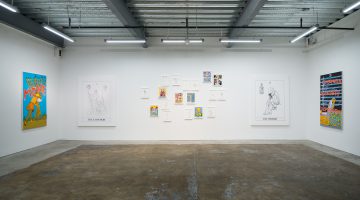Contributed by Lucas Soi
Mike Goldby
“ Premier Life ”
Tomorrow gallery, Toronto
February 22 – March 17, 2013
Peter Thiel, the American technology investor and co-founder of PayPal, believes that higher-education is the next bubble in the U.S. economy. He has compared university administrators to subprime-mortgage brokers, and called debt-saddled graduates the last indentured workers in the developed world, unable to free themselves even through bankruptcy. According to Thiel, higher-education “is a bubble in a classic sense. To call something a bubble, it must be overpriced and there must be an intense belief in it… there’s this sort of psycho-social component to people taking on these enormous debts when they go to college simply because that’s what everybody’s doing.”
American artists Calla Henkel and Max Pitegoff, graduates of Cooper Union in New York City, have observed that “[a]lmost the entire economy of the young artist is debt-based in a financial sense, particularly the young American artist, who is born into debt from the womb of… higher education.” The increasing professionalization of contemporary art practice has relied heavily on the university to legitimize its acceptability as a career path and spurred the industry’s growth and integration into mainstream society. Educational institutions have democratized the pool of practitioners in the field, making the current boom in contemporary art production a direct result of increased financing from student loan debt. The fashion industry, another business that relies on aspirational branding, went through a similar democratization in the early 1990s. A shift in thinking about prêt-a-porter led fashion houses such as Giorgio Armani, Ralph Lauren and Calvin Klein to create sub-brands such as Armani Exchange, Polo Sport and CK, making their labels accessible to a larger audience. This created a new crop of consumers that required higher amounts of production.
Mike Goldby’s debut solo exhibition “Premier Life” at Tomorrow in Toronto reflects on these economic similarities and the modes of production shared by the fashion and art industries. About to finish his BFA at OCAD University, “Premier Life” is Goldby’s undergraduate thesis exhibition, beginning its run during the month of February when the annual high-profile Fashion Weeks dominate news cycles around the world. The two-room installation is comprised of nine photographs, three sculptures and a video piece that document a studio photo shoot. An initial reading suggests the images are self-reflexive, recording the same shoot that produced these photographs. The images are staged in the documentary style of German artist Barbara Probst, who captures the same moment in time from different vantage points, interrogating the idea that a single photograph represents the entire truth. As elements of the installation coalesce, however, they begin to take on a new meaning, suggesting a different scenario altogether. The sculptures, one a table made out of a large piece of glass resting on top of two white sawhorses; the other a stand-alone, black-framed shelving unit, are overlaid with vinyl text in the font of American artist Barbara Kruger. One passage begins:
SHE WAKES UP AFTER TEN, HAIR IN KNOTS, GROANING.
SHE ARRIVES LATE AND THE PHOTOGRAPHER SCOLDS HER.
STILL, SHE STARES AT THE CAMERA INTENTLY.
This narrative element helps to contextualize the exhibition and situate it in the same way that a branding strategy operates: distinct elements come into focus through the filter of recognizable symbols. The text in the exhibition operates as a logo. The images focus on the models’ clothing: a pair of Timberlands and Nike Air Force Ones; an Adidas track jacket; an Everlast t-shirt; each item is isolated by their brand logo. While all of these labels have been around for decades, they are contrasted with another perennial look: denim. In separate pictures two distinct ensembles are highlighted: a bleached denim pants-and-jacket combination, and a raw denim jacket and backwards fitted baseball cap.
The contrast of the same material’s usage from different decades (the 1980s style of denim juxtaposed with its 2000s look) denotes the repetition of time and the limits of innovation. This concept is echoed by the inherent symbolism of water and fire in the spray-painted water bottles and lighters that delicately litter the exhibition. How fitting is it then that the professional student’s condition of debt aligns with editor-in-chief of American Vogue Anna Wintour’s description that “fashion’s not about looking back. It’s always about looking forward.” Art history has always been an archive of trends that have come and gone, disappeared and reappeared, and the cycle of time reflects the current cycle of education, where the MFA follows the BFA, the artist entering and exiting the institution as they both go in and out of style.
–
Shaffer, Matthew. “Back to the Future with Peter Thiel.” National Review Online. 20 Jan 2011 <http://www.nationalreview.com/articles/257531/back-future-peter-thiel-interview?pg=3>
Pinto, Ana Teixeira. “All Tomorrow’s Parties.” Mousse No. 35, October 2012: 152-155. Print.
Okonkwo, Uche. “Luxury Fashion Branding: Trends, Tactics, Techniques”. London: Palgrave Macmillan, 2007.
Onstad, Katrina. “The real cost of our ‘fast fashion’ consumption culture.” The Globe And Mail. 29 Nov 2012
“The September Issue”. Dir: R.J. Cutler. Perf: Anna Wintour, Hamish Bowles. Roadside Attractions, 2009. DVD.










